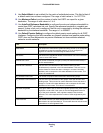
Routing
235
ProSafe M5300 Switch
3. Use Metric to specify the metric of the default route. The range of valid values is 0 to
16777214.
4. Use Metric Type to set the OSPF metric type of the default route. Two types are supported:
• External Type 1
• External Type 2 - Default is External Type 2.
OSPF Configuration
1. Use Router ID to specify the 32-bit integer in dotted decimal format that uniquely
identifies the router within the autonomous system (AS). If you want to change the
Router ID you must first disable OSPF. After you set the new Router ID, you must
re-enable OSPF to have the change take effect. The default value is 0.0.0.0, although
this is not a valid Router ID.
2. Use Admin Mode to select enable or disable. If you select enable, OSPF will be activated
for the switch. The default value is disable. You must configure a Router ID before OSPF
can become operational; see step 1 or by issuing the CLI command:
(Config-router)#router-id.
3. Enable or disable RFC 1583 Compatibility to specify the preference rules that will be used
when choosing among multiple AS-external-LSAs advertising the same destination. If you
select enable, the preference rules will be those defined by RFC 1583. If you select disable,
the preference rules will be those defined in Section 16.4.1 of the OSPF-2 standard (RFC
2328), which will prevent routing loops when AS-external-LSAs for the same destination
have been originated from different areas. The default value is 'enable'. All routers in the
OSPF domain must be configured the same. If all OSPF routers are capable of operating
according to RFC 2328, RFC 1583 Compatibility should be disabled.
4. Set the Opaque LSA Status parameter to enable if OSPF should store and flood opaque
LSAs. An opaque LSA is used for flooding user-defined information within an OSPF router
domain.
5. Use Exit Overflow Interval(secs) to specify how long OSPF must wait before attempting to
leave overflow state. When the number of non-default external LSAs exceeds a configured
limit, the router enters an overflow state as defined in RFC 1765. In overflow state, OSPF
cannot originate non-default external LSAs. If the Exit Overflow Interval is 0, OSPF will not
leave overflow state until it is disabled and re-enabled. The range is 0 to 2,147,483,647
seconds.
6. Use SPF DelayTime (secs) to specify the number of seconds from when OSPF receives a
topology change to the start of the next SPF calculation. Delay Time is an integer from 0 to
65535 seconds. The default time is 5 seconds. A value of 0 means that there is no delay;
that is, the SPF calculation is started upon a topology change.
7. Use SPF HoldTime (secs) to specify the minimum time in seconds between two
consecutive SPF calculations. The range is 0 to 65,535 seconds. The default time is 10
seconds. A value of 0 means that there is no delay; that is, two SPF calculations can be
done, one immediately after the other.
8. Use External LSDB Limit to set the number of the external LSDB limit for OSPF. If the
value is -1, then there is no limit. When the number of non-default AS-external-LSAs in a
router's link-state database reaches the external LSDB limit, the router enters overflow state.
The router never holds more than the external LSDB limit none-default AS-external-LSAs in
database. The external LSDB limit MUST be set identically in all routers attached to the
OSPF backbone and/or any regular OSPF area. The range for limit is -1 to 2147483647.


















